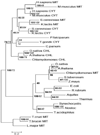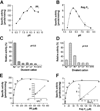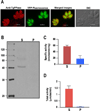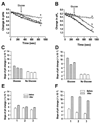Overexpression of a cytosolic pyrophosphatase (TgPPase) reveals a regulatory role of PP(i) in glycolysis for Toxoplasma gondii
- PMID: 21831041
- PMCID: PMC4874478
- DOI: 10.1042/BJ20110641
Overexpression of a cytosolic pyrophosphatase (TgPPase) reveals a regulatory role of PP(i) in glycolysis for Toxoplasma gondii
Abstract
PP(i) is a critical element of cellular metabolism as both an energy donor and as an allosteric regulator of several metabolic pathways. The apicomplexan parasite Toxoplasma gondii uses PP(i) in place of ATP as an energy donor in at least two reactions: the glycolytic PP(i)-dependent PFK (phosphofructokinase) and V-H(+)-PPase [vacuolar H(+)-translocating PPase (pyrophosphatase)]. In the present study, we report the cloning, expression and characterization of cytosolic TgPPase (T. gondii soluble PPase). Amino acid sequence alignment and phylogenetic analysis indicates that the gene encodes a family I soluble PPase. Overexpression of the enzyme in extracellular tachyzoites led to a 6-fold decrease in the cytosolic concentration of PP(i) relative to wild-type strain RH tachyzoites. Unexpectedly, this subsequent reduction in PP(i) was associated with a higher glycolytic flux in the overexpressing mutants, as evidenced by higher rates of proton and lactate extrusion. In addition to elevated glycolytic flux, TgPPase-overexpressing tachyzoites also possessed higher ATP concentrations relative to wild-type RH parasites. These results implicate PP(i) as having a significant regulatory role in glycolysis and, potentially, other downstream processes that regulate growth and cell division.
Figures








Similar articles
-
Structural and Biochemical Characterization of Apicomplexan Inorganic Pyrophosphatases.Sci Rep. 2017 Jul 12;7(1):5255. doi: 10.1038/s41598-017-05234-y. Sci Rep. 2017. PMID: 28701714 Free PMC article.
-
Isolation and characterization of TgVP1, a type I vacuolar H+-translocating pyrophosphatase from Toxoplasma gondii. The dynamics of its subcellular localization and the cellular effects of a diphosphonate inhibitor.J Biol Chem. 2003 Jan 10;278(2):1075-85. doi: 10.1074/jbc.M209436200. Epub 2002 Oct 30. J Biol Chem. 2003. PMID: 12411435
-
Vacuolar proton pyrophosphatase activity and pyrophosphate (PPi) in Toxoplasma gondii as possible chemotherapeutic targets.Biochem J. 2000 Aug 1;349 Pt 3(Pt 3):737-45. doi: 10.1042/bj3490737. Biochem J. 2000. PMID: 10903134 Free PMC article.
-
Biochemical, Structural and Physiological Characteristics of Vacuolar H+-Pyrophosphatase.Plant Cell Physiol. 2018 Jul 1;59(7):1300-1308. doi: 10.1093/pcp/pcy054. Plant Cell Physiol. 2018. PMID: 29534212 Review.
-
Vacuolar H(+)-translocating pyrophosphatases: a new category of ion translocase.Trends Biochem Sci. 1992 Sep;17(9):348-53. doi: 10.1016/0968-0004(92)90313-x. Trends Biochem Sci. 1992. PMID: 1329278 Review.
Cited by
-
The Toxoplasma Vacuolar H+-ATPase Regulates Intracellular pH and Impacts the Maturation of Essential Secretory Proteins.Cell Rep. 2019 May 14;27(7):2132-2146.e7. doi: 10.1016/j.celrep.2019.04.038. Cell Rep. 2019. PMID: 31091451 Free PMC article.
-
A CTP Synthase Undergoing Stage-Specific Spatial Expression Is Essential for the Survival of the Intracellular Parasite Toxoplasma gondii.Front Cell Infect Microbiol. 2018 Mar 22;8:83. doi: 10.3389/fcimb.2018.00083. eCollection 2018. Front Cell Infect Microbiol. 2018. PMID: 29623259 Free PMC article.
-
H+-translocating pyrophosphatases in protozoan parasites.Parasitol Res. 2024 Oct 18;123(10):353. doi: 10.1007/s00436-024-08362-3. Parasitol Res. 2024. PMID: 39419910 Free PMC article. Review.
-
Essential role of pyrophosphate homeostasis mediated by the pyrophosphate-dependent phosphofructokinase in Toxoplasma gondii.PLoS Pathog. 2022 Feb 1;18(2):e1010293. doi: 10.1371/journal.ppat.1010293. eCollection 2022 Feb. PLoS Pathog. 2022. PMID: 35104280 Free PMC article.
-
Maintenance of pyrophosphate homeostasis in multiple subcellular compartments is essential in Plasmodium falciparum.bioRxiv [Preprint]. 2025 Feb 20:2025.02.20.639246. doi: 10.1101/2025.02.20.639246. bioRxiv. 2025. PMID: 40027813 Free PMC article. Preprint.
References
-
- Kornberg A. On the metabolic significance of phosphorolytic and pyrophosphorolytic reactions. In: Kasha HaPB., editor. Horizons in Biochemistry. New York: Academic Press, Inc.; 1962. pp. 251–264.
-
- Mansurova SE. Inorganic pyrophosphate in mitochondrial metabolism. Biochim Biophys Acta. 1989;977:237–247. - PubMed
-
- Veech RL, Cook GA, King MT. Relationship of free cytoplasmic pyrophosphate to liver glucose content and total pyrophosphate to cytoplasmic phosphorylation potential. FEBS Lett. 1980;117(Suppl):K65–K72. - PubMed
-
- Baltscheffsky M, Schultz A, Baltscheffsky H. H+ -PPases: a tightly membrane-bound family. FEBS Lett. 1999;457:527–533. - PubMed
Publication types
MeSH terms
Substances
Associated data
- Actions
- Actions
Grants and funding
LinkOut - more resources
Full Text Sources
Miscellaneous

